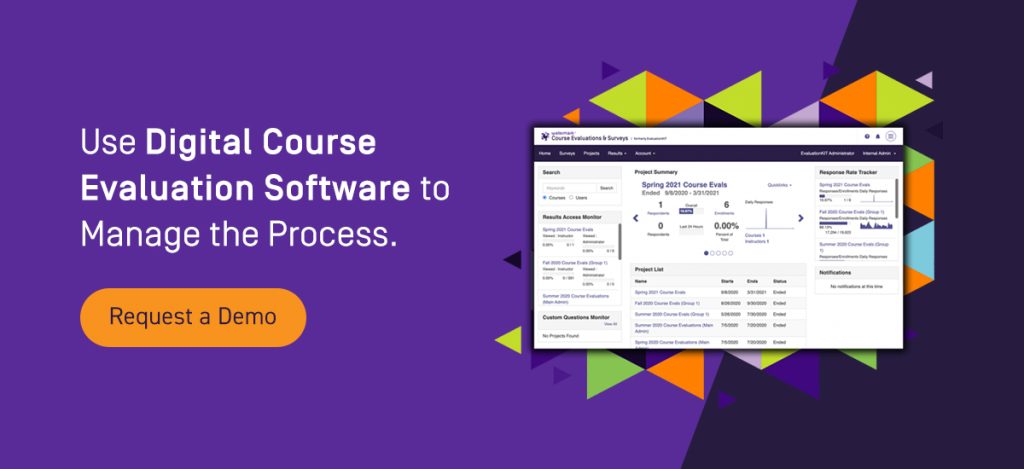




More than ever, getting direct feedback from your students is critical to improving student success at your institution. Many higher education institutions create course evaluation forms to gather student feedback about course structure, professor teaching methods, and other aspects of their institution. Feedback plays an important role in understanding the student experience and improving course delivery and effectiveness.
Before they create a course evaluation form, institutions must plan how they will conduct the survey to draw out the feedback they need from students. Here’s how to create effective course evaluations that students will want to complete, giving you the data you need to improve.
Student feedback can help you improve learning outcomes and your curriculum. You can understand which lecturers and teaching methods work best for students and provide the best learning experience. You can also use their feedback to create an optimal learning environment for current and incoming students, increase student satisfaction, and influence future enrollment.
The following best practices for creating course evaluation forms can guide you to create effective surveys and get the feedback you need from students.
Before creating the best course evaluation questions, determine what you’re trying to measure with the course evaluation and how you will use the information. Some common focus areas include course structure, communication tools, and teaching methods. The goals you want to achieve will inform the type of information that you need to gather. Determine what kind of data you want to collect and why.
Make sure to state the purpose and importance of student feedback at the beginning of your evaluation. Let students know that their feedback is essential to improve their courses and that the faculty values it for their personal growth.
Students take courses across departments and programs, so make sure the base questions and survey length are consistent regardless of which course is under review. Consider using targeted surveys to measure specific elements of a program or course.

Clearly state the purpose of the evaluation up front so that your goal is clear to the student. Questions should be clear, specific, and targeted. Be sure each question addresses a single criterion, and avoid leading questions that introduce bias. For example, avoid prompts like, “The instructor was available to answer questions offline, and all of our course materials were easily accessible online.”
Ensure that your questions are short and relate to your goals. The clearer your questions are, the less likely they will be open to interpretation, and the better the quality of the answers will be.
Use a mixture of question styles. Consider using multi- and single-response questions along with questions with a rating scale. If you include questions on a rating scale, ensure that you define the rating to avoid confusion. For example, 1 = excellent and 5 = very poor.
Open-ended feedback can be valuable, as it allows you to gather direct comments. Still, you need to be strategic when asking for it. If you include write-in questions, clearly indicate what type of feedback you want (instead of using a generic field like “Additional Comments”).
Be strategic about the questions you include and limit the number of custom questions teachers and administrators can add. Be mindful that students need to complete multiple evaluations, so keep it brief and to the point. The shorter the evaluation, the more likely students will complete it, so you’ll have higher response rates. If the survey is concise, students will stay engaged and take the time to provide genuine and honest feedback.
Tell students how long it should take them to fill it out when you send the survey. When they know what to expect, they can set aside enough time to complete it, which reduces the inclination to opt out.
Reinforce to students that feedback is anonymous and that you will keepresponses confidential. Students may not want to give honest feedback if they are worried about faculty identifying them. Confidentiality encourages candid feedback and helps boost response rates.
Consider excluding questions about student demographics, especially in classes where students may be easily identified based on race, ethnicity, gender, level, or major.
Instead of using an external program, integrate your surveys into your internal systems. Making evaluations available on your systems will make them more accessible for all students and increase your response rates. Surveys should be flexible and convenient for students to complete. They should be able to choose whether to complete the survey on a laptop, tablet, smartphone, or desktop. Ease of access and convenience will enhance the quality of the feedback, as students can complete them when it is most convenient for them.
Your course evaluations are an invaluable tool for gathering data about student engagement. They also help you understand whether you are serving the needs of your students. Creating a course evaluation using best practices will ensure you receive the reliable feedback you need to benefit your students and institution.
An online course evaluation solution like Watermark Course Evaluations & Surveys (formerly EvaluationKIT) makes it convenient for students to provide feedback anytime, anywhere. The software turns feedback from surveys into actionable insights that you can use to improve learning and teaching outcomes. If you need valuable feedback from your course evaluations or have questions about how to do a course evaluation, Watermark can help. Learn more about our software by requesting a demo today!


























































































































































































































































































































































































Submit this form to schedule a meeting with one of our reps to learn more about our solutions. If you need customer support instead, click here.